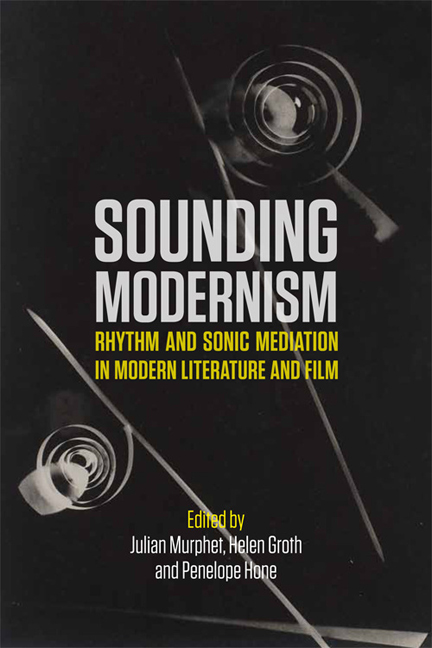Book contents
- Frontmatter
- Contents
- Acknowledgements
- 1 Introduction: Sounding Modernism 1890–1950
- Part One Writing Modern Sound
- Part Two Mediated Voices
- 4 Bottled Bands: Automatic Music and American Media Publics
- 5 How to Listen to Joyce: Gramophones, Voice and the Limits of Mediation
- 6 Sounding Region, Writing Accent: A. G. Street and the BBC
- 7 Partial to Opera: Sounding Willa Cather's Empty Rooms
- 8 Elliptical Sound: Audibility and the Space of Reading
- Part Three Difficult Voices
- Part Four Modern Rhythm: Writing, Sound, Cinema
- Notes on Contributors
- Bibliography
- Index
5 - How to Listen to Joyce: Gramophones, Voice and the Limits of Mediation
from Part Two - Mediated Voices
Published online by Cambridge University Press: 22 December 2017
- Frontmatter
- Contents
- Acknowledgements
- 1 Introduction: Sounding Modernism 1890–1950
- Part One Writing Modern Sound
- Part Two Mediated Voices
- 4 Bottled Bands: Automatic Music and American Media Publics
- 5 How to Listen to Joyce: Gramophones, Voice and the Limits of Mediation
- 6 Sounding Region, Writing Accent: A. G. Street and the BBC
- 7 Partial to Opera: Sounding Willa Cather's Empty Rooms
- 8 Elliptical Sound: Audibility and the Space of Reading
- Part Three Difficult Voices
- Part Four Modern Rhythm: Writing, Sound, Cinema
- Notes on Contributors
- Bibliography
- Index
Summary
In 1932 Christina Stead, living in Paris and struggling to finish her first novel Seven Poor Men of Sydney (1934), purchased a gramophone recording of James Joyce reading from the ‘Anna Livia Plurabelle’ section of Finnegans Wake. Prompted by the publication of Joyce's Work in Progress in Eugene Jolas's avant-garde little magazine transition, Stead's account in a letter to a friend of her frustration with her costly purchase reveals both the powerful allure of Joyce, the celebrity and cachet associated with his signature style and voice, as well as the disappointing reality of early gramophone recordings. Stead writes excitedly, ‘a gramophone record of James Joyce the English litterateur, reading from his own works, a rare thing costing 200 francs’. Given Stead's description of Joyce as English, her alienated response to the recording in which Joyce assumes various Dublin accents is hardly surprising. Indeed one of the many pleasures of listening to Joyce's ‘beautiful’ performance of ‘Anna Livia’, as Sylvia Beach effused in Shakespeare and Company, was Joyce's amusing ‘rendering of an Irish washerwoman's brogue!’ Distracted by the logistics of acquiring the recording, Stead fails to hear, or at least to note, these nuances of accent and place in her letter. She tells her friend that not only does the recording, which was made at the Cambridge Orthological Institute by the renowned linguist C. K. Ogden, cost 200 francs, you have to pay the full amount before listening ‘on the pretense that it wears the record (and I suppose once you have had the experience you are not so likely to buy it)’.
Compounding this disappointment is the confusion and uncertainty that hearing Joyce's performance of his characters’ distinctively Irish voices prompts in Stead. Rather than enhancing her understanding of the complexities of Joyce's linguistic experimentation, which she admiringly describes in the same letter, Stead finds her hopes of a more revelatory form of communication dashed: ‘I have had to telegraph and telephone and visit to get this record and now I am not sure of it’ (51).
- Type
- Chapter
- Information
- Sounding ModernismRhythm and Sonic Mediation in Modern Literature and Film, pp. 63 - 76Publisher: Edinburgh University PressPrint publication year: 2017



